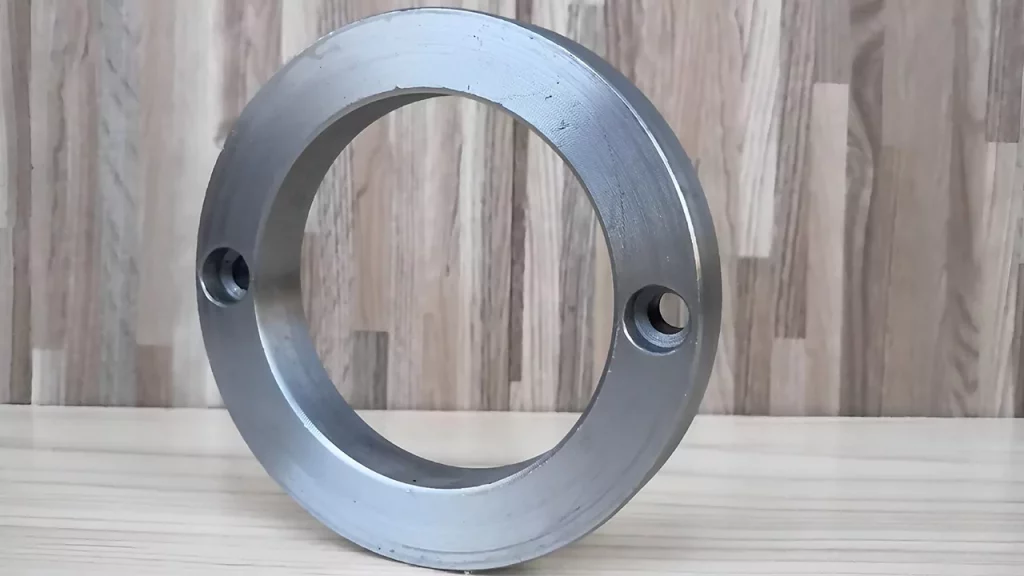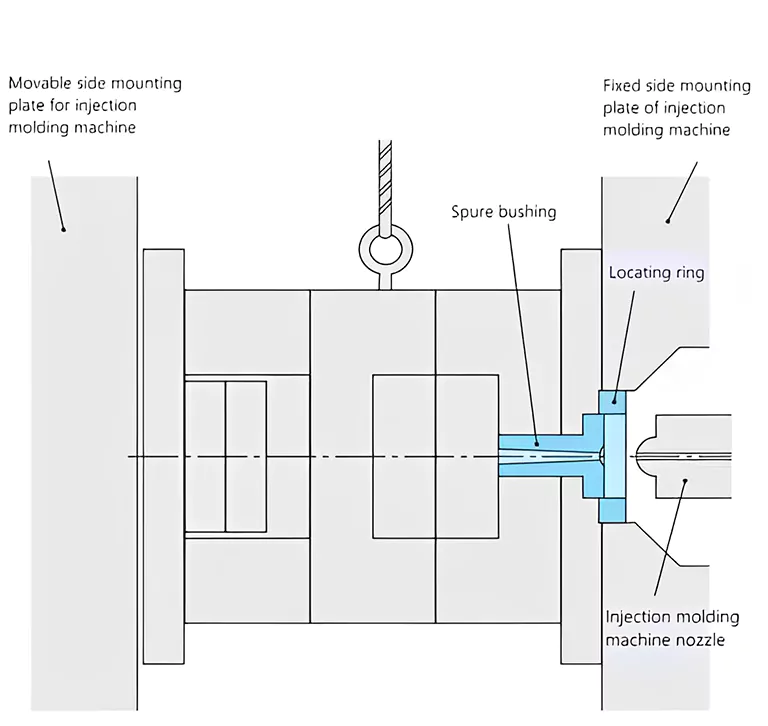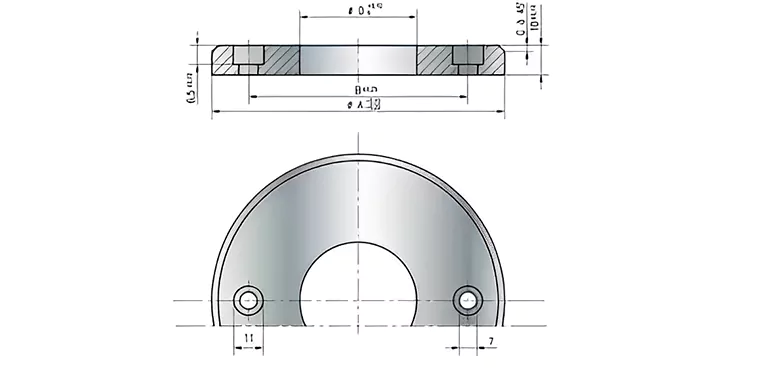An injection mold requires a large amount of time to design. Steel kinds, heat treatment, surface finish, gate size, and other factors are carefully addressed. But how much thought goes into choosing the location ring? In many circumstances, it is insufficient.
But did you know that selecting the proper locating ring is as critical as selecting any other component used in the injection molding process?
This article will go through how location rings operate, how to use them, and what to look for when selecting one for injection molding.
What is a Locating Ring:

A location ring is a component utilized in the injection molding process and is used to place a mold within an injection molding machine. It is connected to the ejector system and is positioned on the machine’s movable platen, which moves back and forth. Even though it is a relatively simple component, the injection mold locating ring is significant in securing the mold base to the injection molding machine.
Also Read: Die Casting Vs Injection Molding: The Most Comprehensive Comparison
Design of a Locating Ring:
A locating ring’s main function is to locate or align the orifice present in the hot or cold sprue with a hole in the machine’s stationary plate.
There are several different methods through which this task can be accomplished.
The orifice for the sprue is often located in the middle of the sprue bushing, and the locating ring is used to align the bushing with the platen’s middle. An important deviation from this rule occurs when employing a MUD or quick-change frame. In this instance, the location ring is responsible for properly aligning the frame to the platen.
In most cases, the locating ring will be situated in the exact middle of the mold. However, there are situations in which the locating ring is moved off-center by a few inches to reduce the mold base size.
One example is when there is just one cavity, and the part is edge-gated.
Additionally, it is offset in a MUD or other quick-change frame designed in the “U” shape. No matter where the locating ring is positioned, it must always be concentric with the opening of the sprue. This is an absolute requirement.
However, if avoided, it can result in a misalignment between the molded sprue and the nozzle tip of the machine.
Generally speaking, according to the American standard, a location ring will have an outside diameter of 3.990 inches. Misalignment can also be caused by rings that are either too small or installed in a counter-bore larger than 3.991 inches.
Injection-Molded Location Ring: How Does It Work?
In the mold hot runner system, the gate jacket can be located using a metal ring called the locating ring. It can withstand high temperatures and is accurate to a great degree. There are two types: A and B; however, there are also several models for individuals with specific requirements.
When the injection molding machine is placed on the movable mold, the mold location ring helps keep the nozzle position of the injection molding machine and the gate sleeve of the injection mold at the same level and completely line up with each other.

During manufacturing, such as injection molding, a location ring is a device fitted around an object and clamps it into the appropriate position. This device helps retain an object in the desired position during manufacturing.
During the injection molding process, the object will actually maintain its position, leading to an enhanced overall quality of the final product.
There is a wide selection of locating rings from which to pick, and the type that is most suitable for a given task will be determined by considerations such as the dimensions and contours of the component that will be molded.
However, combining several locating rings in certain circumstances can help achieve the desired effect.

Types of Locating Ring:
There are several variants of the locating ring to choose from. Most are installed in a counter-bore 7/32 inches deep and in either the top or the injection clamp plate.
Standard Type:
The most fundamental or “standard” type of location ring can correctly line a mold to a platen, but it is not very user-friendly, particularly when used with big molds. It doesn’t go beyond the face of the clamp plate by more than 5/16 of an inch.
The “LN” version, designed exclusively for the older machines manufactured by Lester and Newbury, is just 7/32 in. in length.
Tampered Type:
Another variety of locating rings, known as the tampered type, has a lead-in that is either tapered or extended. On the manufacturing floor, those in charge of setting up are always happy to see something like this.
This type makes it possible to place the mold within the machine more quickly and easily, reducing the risk of causing damage to the ring and the plate. Most extended lead-in locating rings have a depth of 25/32 inches beyond the face of the clamp plate on the mold.
The original length of the tapering part is approximately 7/16 of an inch. The needed land length is the remaining straight part that measures 5/16 of an inch. Most locating rings available for purchase and have a tapered or “extended” lead-in will not function well with molds that include a high-temperature insulation layer.
Insulation sheets normally have a thickness of one-quarter or one-half of an inch. Even the thinner sheet of 14 inches will eliminate practically all of the land length necessary to keep the ring in place in the platen.
In this scenario, you will require a location ring that is larger in diameter and intended to fit an insulator sheet in particular. Unfortunately, only a very small number of providers carry this particular form of a ring with a tapered lead-in that assists in guiding the mold into the platen orifice.
Clamp Type:
Another variety of locating rings, the “clamp” type, is also available. To keep the sprue bushing in place and prevent it from “blowing back,” this kind of ring has an interior diameter that is stepped down to 13/4 inches.
In most cases, bushings are attached to the mold base using one or two 1/4-20 socket-head cap screws that are threaded through the shoulder of the bushing. This further machining step is unnecessary since the clamp-type location ring removes its need.
Additionally, no exposed screws on the front of the bushing need to be filled with plastic. When the bushing needs to be orientated owing to a runner or part shape, you must install a dowel pin, key, or another alignment device.
If the alignment of the sprue bushing is crucial, it is advisable to key the bushing to the mold base rather than the location ring. The majority of locating rings are held in place by socket-head cap screws.
Because the screws have clearance around their head and body, the locating ring (and sprue bushing) can spin one or more degrees.
4 Advantages of Locating Ring:
A location ring offers various benefits as a crucial component in injection molding. These benefits include:
Firm Mold Alignment:
A locating ring is used in plastic injection molding to help hold the mold and ensure the molten plastic is injected in the precise spot. It is beneficial to line the machine nozzle with the sprue bush’s middle length.
Correct Mold Positioning:
The purpose of the sprue bush is to accurately position and align the mold on the injection machine, ensuring proper alignment between the nozzle and the outer diameter sprue bush and preventing any potential leakage.
Mold Setup Time Can Be Cut:
Producers can cut the time and effort required to set up the mold and the quantity of material wasted during the injection process by employing a location ring.
Creating Consistent Shapes and Sizes:
Additionally, the locating ring guarantees that molded parts have a consistent shape and size, which helps to improve the end product’s quality. As a result, a locating ring has numerous advantages for producers and consumers.
Things to Consider When Choosing a Locating Ring:
Various varieties of locating rings are on the market, so selecting the model that best meets your needs is critical. Here are tips to assist you in choosing the most suitable type of location ring:
- Identify the Application: First, determine the application and select the proper locating ring type.
- Considerations for Size and Dimensions: The next step is to consider the ring’s size and measurements. Choose rings of the appropriate size for your purpose.
- Material of the Ring: Following that, it is critical to investigate the ring’s material. Because different materials have varied qualities, you must select the appropriate material for your application.
- Pricing: Once you’ve determined the material you require, it’s time to select a locating ring made of the same material that fits within your budget. Choose a ring that is within your pricing range.
- Examine the Supplier: You cannot work with just any supplier. Instead, select a known, trustworthy source that can give you a high-quality product.
Conclusion:
To build a decent injection mold, the injection mold’s components and accessories must be properly thought out. Having said that, the injection mold location ring is a simple item, but it is critical for attaching the injection mold to the injection molding machine.










